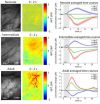(Press-News.org) EAST LANSING, Mich. — Today's consumers switch between media forms so often – from TV to laptops to smart phones – that capturing their attention with advertising has gone, as one CEO explained, from shooting fish in a barrel to shooting minnows.
Now, a Michigan State University business scholar and colleagues have developed the most accurate model yet for targeting those fast-moving minnows. The research-based model predicts when during the day people use the varying forms of media and even when they are using two or more at a time, an increasingly common practice known as media multiplexing.
That's good news for companies struggling to predict when to buy ads on the Internet, television and radio, and in print publications. Previous models for predicting when consumers use media were 60 percent-70 percent accurate; the new model led by MSU's Chen Lin has proved 97 percent accurate.
"For businesses, our model does a much better job of predicting where your customers are at any given time," said Lin, assistant professor of marketing. "It represents a significant advancement over other models because much of that work assumed people consumed one type of media at a time."
The study, published in the academic journal Marketing Science, is based on a survey of the media-consumption habits of nearly 2,000 U.S. residents. Lin and colleagues used the survey data to create their complex forecasting model.
Among the study findings:
People spend about 35 percent of their time consuming media.
Television is still the most popular outlet, followed by computer.
During the weekend, consumers spend more time watching TV and reading print publications and less time on the computer and listening to radio.
People spend about 1.5 hours a day consuming multiple media at the same time (e.g., surfing the Web while watching TV). This happens more at during the start of the workday and before bed – at about 9 a.m. and again at 9 p.m.
Chen also said she was surprised to find consumers still value print media at certain times, particularly in the morning. Print was especially popular when it was paired with other forms of media.
"The old thinking is that print is endangered, but we found that it doesn't need to be eliminated," Lin said. "Print can have a second life if it's cleverly paired with new media such as personal computers and smart phones."
In fact, Lin said ad buyers should stop considering the different media forms as competing and instead view them as complimentary. For example, print ads should be partnered with radio and Internet media forms in the key time slots when consumers are likely to be using all three forms.
"Our findings underscore the need to move away from a competitive mindset to a coordinated viewpoint," Lin said, "as consumers increasingly use combinations of media forms in short periods."
INFORMATION:
Lin's co-authors are Sriram Venkataraman from the University of North Carolina and Sandy Jap from Emory University.
Buying ad time just got easier
2013-02-19
ELSE PRESS RELEASES FROM THIS DATE:
Could a computer on the police beat prevent violence?
2013-02-19
ANN ARBOR, Mich. — As cities across America work to reduce violence in tight budget times, new research shows how they might be able to target their efforts and police attention – with the help of high-powered computers and loads of data.
In a newly published paper, University of Michigan Medical School researchers and their colleagues have used real police data from Boston to demonstrate the promise of computer models in zeroing in on violent areas.
They combined and analyzed information in small geographic units, on police reports, drug offenses, and alcohol availability ...
Russian fireball largest ever detected by CTBTO's infrasound sensors
2013-02-19
Infrasonic waves from the meteor that broke up over Russia's Ural mountains last week were the largest ever recorded by the CTBTO's International Monitoring System. Infrasound is low frequency sound with a range of less than 10 Hz. The blast was detected by 17 infrasound stations in the CTBTO's network, which tracks atomic blasts across the planet. The furthest station to record the sub-audible sound was 15,000km away in Antarctica.
The origin of the low frequency sound waves from the blast was estimated at 03:22 GMT on 15 February 2013. People cannot hear the low frequency ...
Researchers create semiconductor 'nano-shish-kebabs' with potential for 3-D technologies
2013-02-19
Researchers at North Carolina State University have developed a new type of nanoscale structure that resembles a "nano-shish-kebab," consisting of multiple two-dimensional nanosheets that appear to be impaled upon a one-dimensional nanowire. But looks can be deceiving, as the nanowire and nanosheets are actually a single, three-dimensional structure consisting of a single, seamless series of germanium sulfide (GeS) crystals. The structure holds promise for use in the creation of new, three-dimensional (3-D) technologies.
The researchers believe this is the first engineered ...
Theory of crystal formation complete again
2013-02-19
Exactly how a crystal forms from solution is a problem that has occupied scientists for decades. Researchers at Eindhoven University of Technology (TU/e), together with researchers from Germany and the USA, are now presenting the missing piece. This classical theory of crystal formation, which occurs widely in nature and in the chemical industry, was under fire for some years, but is saved now. The team made this breakthrough by detailed study of the crystallization of the mineral calcium phosphate –the major component of our bones. The team published their findings yesterday ...
New study shows how seals sleep with only half their brain at a time
2013-02-19
TORONTO, ON – A new study led by an international team of biologists has identified some of the brain chemicals that allow seals to sleep with half of their brain at a time.
The study was published this month in the Journal of Neuroscience and was headed by scientists at UCLA and the University of Toronto. It identified the chemical cues that allow the seal brain to remain half awake and asleep. Findings from this study may explain the biological mechanisms that enable the brain to remain alert during waking hours and go off-line during sleep.
"Seals do something biologically ...
We know when we're being lazy thinkers
2013-02-19
Are we intellectually lazy? Yes we are, but we do know when we take the easy way out, according to a new study by Wim De Neys and colleagues, from the CNRS in France. Contrary to what psychologists believe, we are aware that we occasionally answer easier questions rather than the more complex ones we were asked, and we are also less confident about our answers when we do. The work is published online in Springer's journal Psychonomic Bulletin & Review.
Research to date on human thinking suggests that our judgment is often biased because we are intellectually lazy, or ...
NYU's Shedlin publishes study on the health of Colombian refugees in Ecuador
2013-02-19
New York University College of Nursing's Professor Michele Shedlin, PhD, recently published a paper, "Sending-Country Violence and Receiving-Country Discrimination: Effects on the Health of Colombian Refugees in Ecuador," on-line in the Journal of Immigrant and Minority Health, February 2, 2013.
Studies of immigrant health have historically focused on individual-level risk factors more than environmental/structural factors as salient mediating variables. Shedlin's research addresses the need to reach a more complete understanding of the migration process and vulnerabilities ...
Study shows that diet of resistant starch helps the body resist colorectal cancer
2013-02-19
As the name suggests, you can't digest resistant starch so it ends up in the bowel in pretty much the same form it entered your mouth. As unlovely as that seems, once in the bowel this resistant starch does some important things, including decreasing bowel pH and transit time, and increasing the production of short-chain fatty acids. These effects promote the growth of good bugs while keeping bad bugs at bay. A University of Colorado Cancer Center review published in this month's issue of the journal Current Opinion in Gastroenterology shows that resistant starch also helps ...
Annals of Internal Medicine tip sheet for Feb. 19, 2013
2013-02-19
1. Acupuncture May be an Effective Alternative for Treating Seasonal Allergies
Patients receiving acupuncture treatments for seasonal allergic rhinitis reported statistically significant improvements in symptoms and decreased use of medication compared to patients having standard treatment or sham acupuncture, but the clinical significance of the observed improvements is uncertain. Allergic rhinitis (stuffy or runny nose caused by allergies) is an extremely common condition that affects approximately 20 percent of the U.S. population. Despite the availability of effective ...
Shedding new light on infant brain development
2013-02-19
New York, NY—February 18, 2013—A new study by Columbia Engineering researchers finds that the infant brain does not control its blood flow in the same way as the adult brain. The paper, which the scientists say could change the way researchers study brain development in infants and children, is published in the February 18 Early Online edition of Proceedings of the National Academy of Sciences (PNAS).
"The control of blood flow in the brain is very important" says Elizabeth Hillman, associate professor of Biomedical Engineering and of Radiology, who led the research study ...




